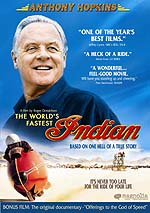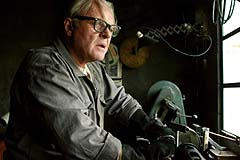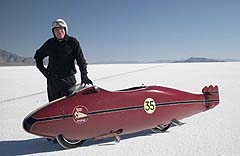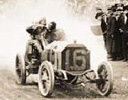DVD Review
by Russell Jaslow
The World's Fastest Indian
Starring Anthony Hopkins
A film by Roger Donaldson
Magnolia Pictures
 In 1971, Roger Donaldson, then a young aspiring New Zealand filmmaker, made a documentary called, "Offerings to the God of Speed." It was a story about Burt Munro, a fellow Kiwi, who was obsessed with a 1920 Indian Scout motorcycle.
In 1971, Roger Donaldson, then a young aspiring New Zealand filmmaker, made a documentary called, "Offerings to the God of Speed." It was a story about Burt Munro, a fellow Kiwi, who was obsessed with a 1920 Indian Scout motorcycle.
Donaldson, too, became obsessed. With the subject of his documentary. Like Munro, Donaldson came to America to achieve his dreams. After a long and successful movie making career, Donaldson finally returned to his hero.
"The World's Fastest Indian" is the result of this obsession. Both Munro's and Donaldson's. Munro spent his life tinkering with the motorcycle, which became known as the Indian Munro Special. Donaldson spent his life working on a script that would properly depict Burt Munro.
 Burt Munro was a man from an era where a backyard mechanic could beat the odds and successfully go up against the more established efforts. However, to call Munro a backyard mechanic would do him a disservice. He was a self taught engineer who used any means possible to build, create, and test every part that went into his bike. He had one goal in mind, to keep making it faster. And, when he ran out of space to conquer on his small island nation, he dreamed of running his Indian at the Mecca of speed -- the Bonneville Salt Flats.
Burt Munro was a man from an era where a backyard mechanic could beat the odds and successfully go up against the more established efforts. However, to call Munro a backyard mechanic would do him a disservice. He was a self taught engineer who used any means possible to build, create, and test every part that went into his bike. He had one goal in mind, to keep making it faster. And, when he ran out of space to conquer on his small island nation, he dreamed of running his Indian at the Mecca of speed -- the Bonneville Salt Flats.
Donaldson properly captures this aspect of Munro in the early part of the movie that takes place in New Zealand, which is one of the two best parts of the film. The other is the latter part when Munro makes it to Bonneville and he has to convince the organizers to allow him to run all the while capturing the hearts of his fellow participants. And then of course, the dramatic buildup to the run itself.
The middle part of the film bogs down a bit, especially when Munro first makes it to the U.S. and spends a few days in Hollywood. We already know by this point that Munro is a lovable, eccentric kook who simultaneously frustrates his neighbors while gaining their affection. We didn't need to see that repeated when he goes to a foreign land, especially in a way that makes him appear dumb. Which he is anything but.
 Some may quibble that Donaldson used the poetic license technique of jamming all the factual events into one year. The events that are shown occurred over a span of many years. I don't want to give them away, so I won't get into details. If it gets people to look up the true history of Munro, all the better. But, it doesn't distract from the point of the film.
Some may quibble that Donaldson used the poetic license technique of jamming all the factual events into one year. The events that are shown occurred over a span of many years. I don't want to give them away, so I won't get into details. If it gets people to look up the true history of Munro, all the better. But, it doesn't distract from the point of the film.
At first I was upset when they ran the credits and gave some details about Munro's life afterwards, yet never told us when he died. Then, I realized Burt Munro was never about how something ended. He was all about how one lived. The journey, not the destination. Quite frankly, who cares when Burt Munro died. What matter is what should matter to all of us -- to live life to its fullest and go after your dreams, no matter how long it takes you to achieve them. It is that feeling that you will remember in this inspiring movie.
The recently released DVD has the usual extras (the making of, deleted scenes, feature commentary), but it is the special bonus of the original documentary that makes the DVD a must have. When you watch the original Burt Munro in interviews, saying some of the same lines repeated in the movie, working in his shop, and his mannerisms, you realize even more so how brilliantly Anthony Hopkins recreated this folk hero, in what may be one of Hopkins best performances.
|



